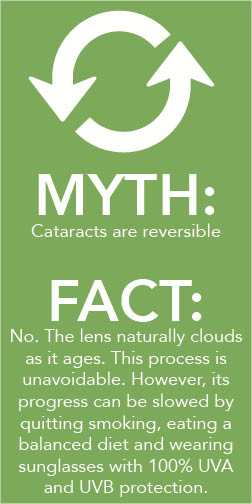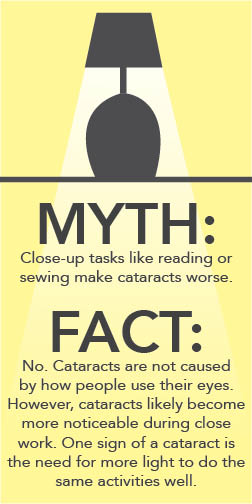What is a cataract?
The crystalline lens is a transparent (clear) structure inside the eye that focuses light into images on the retina. A cataract is the progressive clouding of this lens. Most cataracts are caused by the normal aging process, as proteins clump together on the surface of the lens, and more than half of all people over the age of 60 suffer from cataracts. Diabetes, heredity, eye trauma, and certain medications can accelerate cataract development. Symptoms of cataracts include blurred vision, difficulty reading, ghost images, increased nearsightedness, sensitivity to light and problems driving at night due to glare from lights. Cataracts develop at different rates and can affect only one eye or both eyes at the same time. When a cataract causes significant vision loss or symptoms that interfere with driving, reading or other activities, it should be removed.
Removing the Cataract
Cataract surgery is performed on an outpatient basis with the patient awake. Numbing drops or an injection of local anesthetic make the surgery painless. The most common and most advanced cataract surgery technique is called phacoemulsification. During phaco surgery, a small ultrasonic probe is used to breaks up (emulsify) the cloudy lens into tiny pieces, which are then removed from the eye. Phaco surgery requires only a small incision of 3.5 millimeters (1/8 inch) or less. Stitches are seldom needed to close this tiny wound. This causes less discomfort and allows for a much quicker recovery of vision.
A less common, but sometimes necessary, method of cataract surgery is extracapsular cataract extraction (ECCE). This procedure is primarily used on very advanced cataracts that phacoemuslfication cannot address. ECCE requires a larger incision and removal of the cataract in one piece. This technique may involve more healing time and more discomfort due to the larger incision, which requires stitches.
Once the cataract is removed, an artificial lens implant (called an intraocular lens, or IOL) is gently placed into the eye. Standard IOLs provide clear vision and excellent clarity for distant objects, but more patients who receive these standard lenses will require glasses for near and intermediate vision activities such as reading or using a computer. Thanks to recent advances, we are now proud to offer replacement lenses that are specially designed to reduce or eliminate your dependence on glasses. If one of these lenses better suits your lifestyle, one of our doctors will happy to discuss it with you.
If you are interested in being glasses-free after cataract surgery, click here for more information on these revolutionary lenses.
If you have further questions about cataracts and cataract surgery, click here to access our Cataract FAQ.





